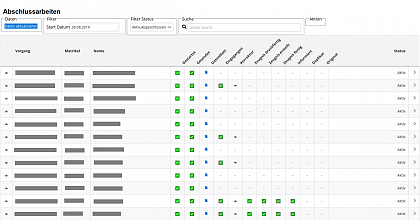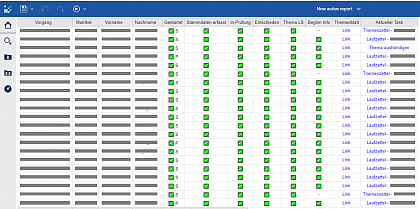Use of an information management system in the ProDig@Students project
Digitization of administrative processes
Since November 2019, the Chair of Business Informatics has been the first pilot to receive a permanent connection to the MLU Information Management System (IMS) as part of the ProDig@Students project. ProDig@Students is based at the Chair of Information Systems, esp. Business Information Management of Prof. Dr. Stefan Sackmann, and deals with the digitalization of administrative processes in the examination office for business administration, including the implementation of corresponding tools and the development of an IT infrastructure.
A core technology of the project is the workflow management system Camunda. It is used to enable the graphical modeling of processes and their execution as well as the connection of external IT services. First, a prototype web-based tool was developed, which displays the running process instances in a simple tabular representation (Figure 1). This tool was positively received by the economic audit office.However, the development effort was very high: despite the plain appearance, complex queries had to be made to the Camunda database to get the correct information. While the prototype was functional, it did not scale sufficiently when processes changed and additional, new processes were added. Therefore, the IMS implemented at the Office of University Planning and Information Management was used as an alternative solution.The connection of ProDig@Students to the IMS includes on the one hand the use of the staff resources and IT infrastructure of the staff office for the linking of Camunda with the IMS, i.e. in detail the setup of the ETL process: extraction of data via http-API, transformation into a new data schema and loading into the underlying IMS data warehouse. On the other hand, a standalone reporting module for the administrative processes in the associated examination office was implemented in the IMS on the part of the staff department. It provides a fine-granular, scalable information basis for real-time control of the distribution of final papers and thus enables, for example, the timely identification of possible distortions.
Experience to date shows that, on the one hand, the IMS enables reports to be created at a significantly higher speed with a lower level of necessary, technical expertise. On the other hand, the creation and change process scales much better for new processes and process changes. Thus, the problem of data evaluation for processes can be addressed in a sustainable way. The process instance overview in Figure 1, which was prototypically implemented as a website, could be replicated in the IMS within a very short time (Figure 2). At the same time, the IMS offers a wide range of evaluation functions that enable further visualizations beyond tabular views.
An evaluation via IMS is possible in real time as well as on-demand. This creates a considerably more fine-grained information situation, which can also be used for real-time control of the final work distribution. Likewise, the time periods considered can be selected as desired, so that temporary distortions in the distributions, e.g. peak times, can be identified on a daily, monthly, quarterly or semester basis. Furthermore, the data determination is automated via the connection to the workflow management system Camunda, so that sources of error are minimized. Furthermore, the data protection-compliant linking of ProDig@Students with the IMS Data Warehouse provides modular, scalable access to project-relevant data. This makes it possible to create further data evaluations for ProDig@Students in the future.

Figure 1: Prototype of a process instance overview for the final thesis process. Partially censored for data protection reasons.

Figure 2: IMS report for the final thesis process. Partially censored for data protection reasons.


